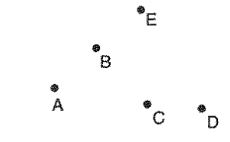Given the following informations about the non-zero vectors A, B and C
(i)(A×B)×A=0:(ii)B⋅B=4
(iii)A⋅B=−6:(iv)B⋅C=6
which one of the following holds good?
A×B=0
A⋅(B×C)=0
A⋅A=8
A⋅C=−1
The correct Answer is:A, B
To solve the problem step by step, we will analyze the given conditions and derive the necessary conclusions.
Given Information:
1. A×(B×A)=0
2. B⋅B=4
3. A⋅B=−6
4. B⋅C=6
Step 1: Analyze the first condition
From the first condition, we have:
A×(B×A)=0
Using the vector triple product identity:
A×(B×A)=(A⋅A)B−(A⋅B)A
Setting this equal to zero gives:
(A⋅A)B−(A⋅B)A=0
Step 2: Substitute known values
Let A⋅A=|A|2 and A⋅B=−6:
|A|2B+6A=0
Rearranging gives:
|A|2B=−6A
Step 3: Express A in terms of B
From the equation |A|2B=−6A, we can express A as:
A=−|A|26B
This implies that A is parallel to B.
Step 4: Check the implications of parallel vectors
If A is parallel to B, then:
A×B=0
Step 5: Analyze the second condition
Now, we take the equation |A|2B+6A=0 and take the cross product with C:
|A|2(B×C)+6(A×C)=0
Step 6: Dot product with A
Taking the dot product with A:
|A|2(A⋅(B×C))+6(A⋅(A×C))=0
Since A×C is perpendicular to A, A⋅(A×C)=0:
|A|2(A⋅(B×C))=0
This implies:
A⋅(B×C)=0
Step 7: Conclusion from the second condition
This means that A is orthogonal to B×C.
Step 8: Analyze the third condition
From A⋅B=−6:
Using the formula:
A⋅B=|A||B|cos(θ)
Since A is parallel to B, the angle θ must be π (180 degrees):
|A|⋅|B|⋅(−1)=−6
Given |B|2=4 implies |B|=2:
|A|⋅2=6
|A|=3
Thus, |A|2=9.
Step 9: Check consistency with the given conditions
However, the problem states that A⋅A=8, which contradicts our derived value of 9. Therefore, this condition is false.
Step 10: Analyze the fourth condition
Using |A|2B+6A=0 and taking the dot product with C:
|A|2(B⋅C)+6(A⋅C)=0
Substituting |A|2=9 and B⋅C=6:
9⋅6+6(A⋅C)=0
54+6(A⋅C)=0
6(A⋅C)=−54
A⋅C=−9
Step 11: Conclusion from the fourth condition
The problem states A⋅C=−1, which is also false.
Final Summary
The only conditions that hold true from the analysis are:
1. A is parallel to B.
2. A⋅(B×C)=0.
1. A×(B×A)=0
2. B⋅B=4
3. A⋅B=−6
4. B⋅C=6
From the first condition, we have:
A×(B×A)=0
A×(B×A)=(A⋅A)B−(A⋅B)A
(A⋅A)B−(A⋅B)A=0
Let A⋅A=|A|2 and A⋅B=−6:
|A|2B+6A=0
|A|2B=−6A
From the equation |A|2B=−6A, we can express A as:
A=−|A|26B
If A is parallel to B, then:
A×B=0
Now, we take the equation |A|2B+6A=0 and take the cross product with C:
|A|2(B×C)+6(A×C)=0
Taking the dot product with A:
|A|2(A⋅(B×C))+6(A⋅(A×C))=0
|A|2(A⋅(B×C))=0
A⋅(B×C)=0
This means that A is orthogonal to B×C.
From A⋅B=−6:
Using the formula:
A⋅B=|A||B|cos(θ)
Since A is parallel to B, the angle θ must be π (180 degrees):
|A|⋅|B|⋅(−1)=−6
|A|⋅2=6
|A|=3
Thus, |A|2=9.
However, the problem states that A⋅A=8, which contradicts our derived value of 9. Therefore, this condition is false.
Using |A|2B+6A=0 and taking the dot product with C:
|A|2(B⋅C)+6(A⋅C)=0
Substituting |A|2=9 and B⋅C=6:
9⋅6+6(A⋅C)=0
54+6(A⋅C)=0
6(A⋅C)=−54
A⋅C=−9
The problem states A⋅C=−1, which is also false.
The only conditions that hold true from the analysis are:
1. A is parallel to B.
2. A⋅(B×C)=0.
Topper's Solved these Questions
- PRODUCT OF VECTORSBOOK - ARIHANT MATHS ENGLISHCHAPTER - PRODUCT OF VECTORSEXERCISE - Exercise (Statement I And Ii Type Questions)
12 Videos
- PRODUCT OF VECTORSBOOK - ARIHANT MATHS ENGLISHCHAPTER - PRODUCT OF VECTORSEXERCISE - Exercise (Passage Based Questions)
21 Videos
- PRODUCT OF VECTORSBOOK - ARIHANT MATHS ENGLISHCHAPTER - PRODUCT OF VECTORSEXERCISE - Exercise (Single Option Correct Type Questions)
71 Videos
- PROBABILITYBOOK - ARIHANT MATHS ENGLISHCHAPTER - PROBABILITYEXERCISE - Exercise (Questions Asked In Previous 13 Years Exam)
54 Videos
- PROPERTIES AND SOLUTION OF TRIANGLES BOOK - ARIHANT MATHS ENGLISHCHAPTER - PROPERTIES AND SOLUTION OF TRIANGLES EXERCISE - Exercise (Questions Asked In Previous 13 Years Exam)
21 Videos
Similar Questions
If b+c+,c+a,a+b are in H.P. then which of the following hold(s) good ?
View SolutionIf a, b and c be the three non-zero vectors satisfying the condition a×b=candb×c=a, then which of the following always hold(s) good?
View SolutionIf a,b,c,d,e are positive numbers, then which of the following holds good
View SolutionIn a triangle ABC, let 2a2+4b2+c2=2a(2b+c) , then which of the following holds good?
View SolutionShow that the following four conditions are equivalent:(i)A⊂B (ii) AB=φ (iii) A∪B=B (iv) A∩B=A
View Solutiona, b, c are the first three terms of geometric series. If the H.M. of a and b is 12 and that of b and c is 36 then which of the following hold(s) good?
View SolutionLet a, b and c are non-zero vectors such that they are not orthogonal pairwise and such that V1=a×(b×c)andV2=(a×b)×c,are collinear then which of the following holds goods?
Option1. a and b are orthogonal
Option 2. a and c are collinear
Option 3. b and c are orthogonal
Option 4. b=λ(a×c) when λ is a scalar
View SolutionIf a and b are two non-zero and non-collinear vectors then a+b and a-b are
View SolutionThe graph of the quadratic trinomial u=ax2+bx+c has its vertex at (4, -5) and two x-intercepts, one positive and one negative. Which of the following holds good? a. a>0 b. b<0 c. c<0 d. 8a=b
View SolutionUsing a ruler, check whether the following points given in fig. 10.20 are collinear or not:
(i)D, A and C (ii) A, B and C (iii)A, B and E (iv) B, C and E

View Solution
